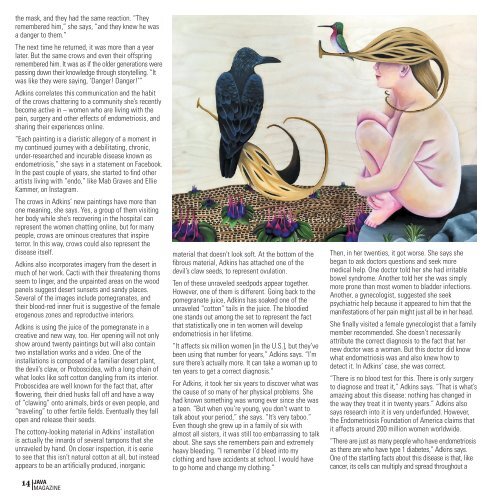Java-Sept-Pages-2018
You also want an ePaper? Increase the reach of your titles
YUMPU automatically turns print PDFs into web optimized ePapers that Google loves.
the mask, and they had the same reaction. “They<br />
remembered him,” she says, “and they knew he was<br />
a danger to them.”<br />
The next time he returned, it was more than a year<br />
later. But the same crows and even their offspring<br />
remembered him. It was as if the older generations were<br />
passing down their knowledge through storytelling. “It<br />
was like they were saying, ‘Danger! Danger!’”<br />
Adkins correlates this communication and the habit<br />
of the crows chattering to a community she’s recently<br />
become active in – women who are living with the<br />
pain, surgery and other effects of endometriosis, and<br />
sharing their experiences online.<br />
“Each painting is a diaristic allegory of a moment in<br />
my continued journey with a debilitating, chronic,<br />
under-researched and incurable disease known as<br />
endometriosis,” she says in a statement on Facebook.<br />
In the past couple of years, she started to find other<br />
artists living with “endo,” like Mab Graves and Ellie<br />
Kammer, on Instagram.<br />
The crows in Adkins’ new paintings have more than<br />
one meaning, she says. Yes, a group of them visiting<br />
her body while she’s recovering in the hospital can<br />
represent the women chatting online, but for many<br />
people, crows are ominous creatures that inspire<br />
terror. In this way, crows could also represent the<br />
disease itself.<br />
Adkins also incorporates imagery from the desert in<br />
much of her work. Cacti with their threatening thorns<br />
seem to linger, and the unpainted areas on the wood<br />
panels suggest desert sunsets and sandy places.<br />
Several of the images include pomegranates, and<br />
their blood-red inner fruit is suggestive of the female<br />
erogenous zones and reproductive interiors.<br />
Adkins is using the juice of the pomegranate in a<br />
creative and new way, too. Her opening will not only<br />
show around twenty paintings but will also contain<br />
two installation works and a video. One of the<br />
installations is composed of a familiar desert plant,<br />
the devil’s claw, or Proboscidea, with a long chain of<br />
what looks like soft cotton dangling from its interior.<br />
Proboscidea are well known for the fact that, after<br />
flowering, their dried husks fall off and have a way<br />
of “clawing” onto animals, birds or even people, and<br />
“traveling” to other fertile fields. Eventually they fall<br />
open and release their seeds.<br />
The cottony-looking material in Adkins’ installation<br />
is actually the innards of several tampons that she<br />
unraveled by hand. On closer inspection, it is eerie<br />
to see that this isn’t natural cotton at all, but instead<br />
appears to be an artificially produced, inorganic<br />
14 JAVA<br />
MAGAZINE<br />
material that doesn’t look soft. At the bottom of the<br />
fibrous material, Adkins has attached one of the<br />
devil’s claw seeds, to represent ovulation.<br />
Ten of these unraveled seedpods appear together.<br />
However, one of them is different. Going back to the<br />
pomegranate juice, Adkins has soaked one of the<br />
unraveled “cotton” tails in the juice. The bloodied<br />
one stands out among the set to represent the fact<br />
that statistically one in ten women will develop<br />
endometriosis in her lifetime.<br />
“It affects six million women [in the U.S.], but they’ve<br />
been using that number for years,” Adkins says. “I’m<br />
sure there’s actually more. It can take a woman up to<br />
ten years to get a correct diagnosis.”<br />
For Adkins, it took her six years to discover what was<br />
the cause of so many of her physical problems. She<br />
had known something was wrong ever since she was<br />
a teen. “But when you’re young, you don’t want to<br />
talk about your period,” she says. “It’s very taboo.”<br />
Even though she grew up in a family of six with<br />
almost all sisters, it was still too embarrassing to talk<br />
about. She says she remembers pain and extremely<br />
heavy bleeding. “I remember I’d bleed into my<br />
clothing and have accidents at school. I would have<br />
to go home and change my clothing.”<br />
Then, in her twenties, it got worse. She says she<br />
began to ask doctors questions and seek more<br />
medical help. One doctor told her she had irritable<br />
bowel syndrome. Another told her she was simply<br />
more prone than most women to bladder infections.<br />
Another, a gynecologist, suggested she seek<br />
psychiatric help because it appeared to him that the<br />
manifestations of her pain might just all be in her head.<br />
She finally visited a female gynecologist that a family<br />
member recommended. She doesn’t necessarily<br />
attribute the correct diagnosis to the fact that her<br />
new doctor was a woman. But this doctor did know<br />
what endometriosis was and also knew how to<br />
detect it. In Adkins’ case, she was correct.<br />
“There is no blood test for this. There is only surgery<br />
to diagnose and treat it,” Adkins says. “That is what’s<br />
amazing about this disease: nothing has changed in<br />
the way they treat it in twenty years.” Adkins also<br />
says research into it is very underfunded. However,<br />
the Endometriosis Foundation of America claims that<br />
it affects around 200 million women worldwide.<br />
“There are just as many people who have endometriosis<br />
as there are who have type 1 diabetes,” Adkins says.<br />
One of the startling facts about this disease is that, like<br />
cancer, its cells can multiply and spread throughout a


















